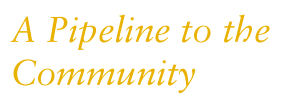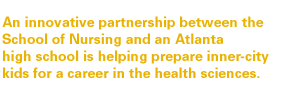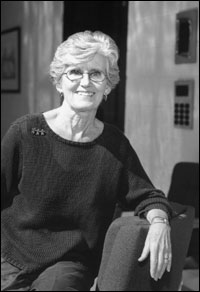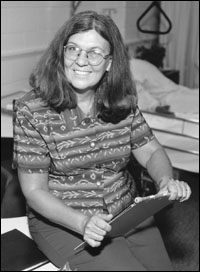 |
By Darryl Gossett |

Look a little closer, though, at this “school within a school,” and you see something quite unusual: a combination of vocational studies with college preparatory courses. This historically African-American institution has a goal for its methods––to get students poised for a career in the health sciences. For language arts credit, for instance, a student might be asked to read Hot Zone, Richard Preston’s 1994 book about an outbreak of Ebola virus. The student might then be assigned to interview an epidemiologist to learn how scientists track and control viral epidemics. Students can earn social studies credit by comparing immunization and eradication efforts in other countries with our own. They then might amplify that comparison with mathematics-based skills in probability and statistics. A science unit might look at slides of bacteria and viruses. The three-year academy seeks to enroll 60 students each year, for a total of 180. These students work to achieve one of three main goals: to find work as a certified nursing assistant (students are ready to sit for their examination by the end of their senior year); to find work as a sports medicine therapist/athletic trainer (introduced because of its appeal to young men); or to gain preparation for admission to a college in a health sciences area (including learning a foreign language to satisfy the state’s college-entrance requirements). The academy was launched in September 1998 by Booker T. Washington High School. The School of Nursing, a key player in the academy advisory group, formed ties with the high school in 1991 in the early days of the Atlanta Project. Soon, the nursing school was joined by Emory’s Woodruff Health Sciences Center, which donated $100,000 to the effort, which also received partial funding from a four-year, $1.6-million Howard Hughes Medical Institute grant. “Our collaboration with the academy meets the priorities of the School of Nursing and theuniversity, to address community needs through interdisciplinary practice and scholarship,” says Associate Professor Madge Donnellan, PhD, RN, director of primary care at the School of Nursing and the point person for the nursing school’s involvement with the academy. “We are working with the faculty at Booker T. to assist them in implementing a health sciences curriculum and help them with problem-based learning approaches. As Emory’s nursing students work with the high school students on risk appraisals, interventions, and health fairs, they create “a two-way avenue of education,” says Donnellan. The Hughes Science Initiative, another Emory participant in the partnership, promotes science education and literacy, particularly among minorities. The Hughes director Pat Marsteller says that “academies are a proven way to increase student achievement, raise academic standards, and improve classroom attendance.” With overlapping goals, Marsteller and Donnellan are working together to establish more interconnections between schools in the Woodruff Health Sciences Center and the academy at Booker T. One plan is to develop a program that matches academy students with Emory mentors, says Donnellan. A complementary program will place academy students in internships throughout the university. One of the first major events of the partnership between Emory and the academy was the Booker T. Washington Health Fair, held this past spring. More than 500 people attended the health fair, where undergraduate and graduate nursing students, as well as academy students, conducted blood sugar and blood pressure screenings, took height and weight measurements, and offered educational material on health and nutrition. Academy students, decked out in white lab coats, were a hit among their peers and were taken seriously when it came to their assessments and lifestyle recommendations. For instance, they recorded an alarming number of high blood pressure readings at the health fair, prompting recommendations for follow-up visits to physicians. The nursing school’s efforts merge nicely with other ongoing efforts at Emory to create pipelines that will move minorities and women into careers in the sciences, particularly into the health sciences. Through collaboration between the university and the community, a new conduit is emerging for recruiting and training the next generation of health professionals.
|
|
Building for the Future | Nursing
Newsbriefs
Dean with a Passion | A Pipeline to the Community |
One Pill at a Time
Donor Report | Alumni
News | Happenings
WHSC
Copyright © Emory University, 2000. All
Rights Reserved.
Send comments to hsnews@emory.edu.


